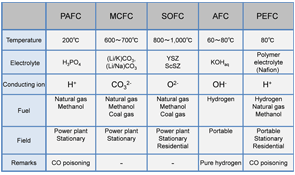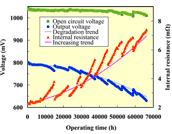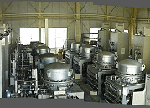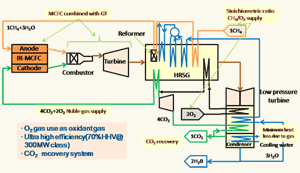|
Fuel cells are different from batteries, they produce electricity from hydrogen gas and oxygen gas. So that, fuel cells can be operated virtually continuously as long as the necessary flows are maintained. Fuel cells can be classified according to their working temperature: high temperature (600 - 1000 °C) and low temperature (60 - 200 °C) fuel cells. CRIEPI has performed the researches of solid oxide fuel cell (SOFC) and polymer electrolyte fuel cell (PEFC) based on the technology cultivated in molten carbonate fuel cell (MCFC) that is one of the high temperature fuel cells. |
< Comparison of fuel cells > |
|
Natural gas and city gas, etc. which are reformed either externally or internally and coal gas through a gas cleanup system are supplied as a fuel for fuel cells. Different system concepts have evolved around the choices for a cleanup, water recovery, reformer type, and operating pressure. So that, the gas compositions are different with different system concepts. CRIEPI has developed the electrode performance model based on a relation equation between coefficients in cathode and anode reaction resistance models. MCFC cell performances with various temperatures, pressures, and gas compositions can be estimated with high accuracy by using this model. |
|
Developed estimation method was applied to the performance analysis of SOFC. Adopting this method enabled the separation into each performance factor in SOFC performance as shown in right-hand-side figure. Hence it extracts which performance factor is major in cell performance, the materials and structures of the appropriate components are efficiently modified, and subsequent the cell performance of SOFC is improved successfully. |
< Performance analysis results for SOFC > |
|
1kW class SOFC system has been tested and the system performance analysis was conducted using the electrode performance model which was derived using single cell tests. It is confirmed that the analysis has good accuracy even if system operating conditions such as temperature, reforming rate, were changed. |
< Performance analysis results for SOFC > |
|
It became possible to operate single cells for several ten thousands hours using pressurized test stands and to verify the high durability of MCFC. The durability prediction based on the electrode performance model, which correlated the performance factor with the physical properties, was established. This method has been applied to evaluate the durability of SOFC and the others. |
|
||||||
|
Currently maximum sending-end efficiency in a LNG power plant is about 54% HHV. Considering the feature of both of a gas turbine and a fuel cell, we designed a new MCFC-GT hybrid system. This system is oxygen blown semi-closed configuration. Using this configuration, the combination of MCFC and combustion turbine became possible. In addition, adopting this system enables not only the carbon dioxide recovery but also to increase the MCFC output power density. As a result of heat and mass balance calculation, the sending-end efficiency of this system proved to be over 70%. Moreover, we arranged development tasks and the strategies to improve efficiency of this system. |
< Schematic diagram of ultra-highly efficiency Considering the feature of both of a gas turbine and a fuel cell, we designed a new MCFC-GT hybrid system.
|










